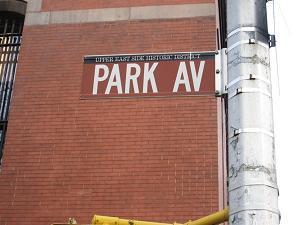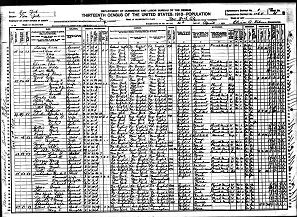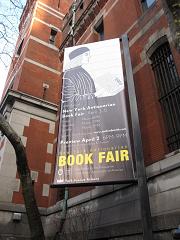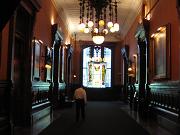7th Regiment ArmoryFrom The Peopling of New York CityHomepage User:Yanwar
Seventh Regiment Armory (Park Avenue Armory)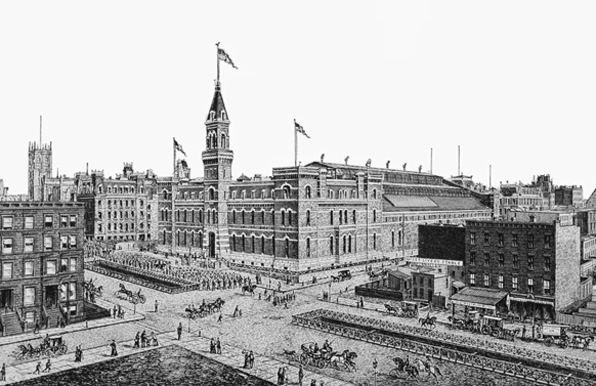 The heart of this investigation lies here. It will be subdivided into several sections. First, I will attempt to answer the questions proposed earlier.The section will delve into the reality of how some “employed” the armory to protect their interests. Next, you will find the detailed results of my findings on two men whose lives where intertwined with that of the Park Avenue Armory: Charles William Clinton and Louis Comfort Tiffany .[2] Based on my findings, I have constructed a narrative of their lives and how they influenced the armory. A Real Estate SchemeAs we walk down Park Avenue, we look around in wonder of how such a place came to be. Our questioning takes us back a few centuries. In the mid 1800s, Park Avenue was known by a different name: Fourth Avenue. In the 19th century, New York & Harlem Railroad, with the permission of the city, decided to run its steam locomotives along Fourth Avenue.[3]. As time moved on, perpetual complaints about noise and sanitation prevented further construction below 42nd Street (this explains why Grand Central is located where it is). Conventional history of the city tells us that as New York City developed, sections of the street were renamed Park Avenue due to the park-like milieu in the surrounding area. [4]. However, the renaming of Fourth Avenue had as much to do with phonetic improvement of the street name as economic interests of the social elite. In fact, a real estate “scheme” was devised to raise property values on Fourth Avenue. [5]. The rails that lead to Grand Central were placed underground in 1927. The construction of this Grand Central Terminal alleviated traffic above the terminal. Fourth Avenue was subsequently renamed to be classier as Park Avenue. Subsequently, property values rose on Park Avenue. Later, part of Fourth Avenue from 17th to 32nd Street was named Park Avenue South.[6] Some of the most expensive real estate in the United States is found on Present-day Park Avenue. It is not unusual to learn that Corporate Executive Officers (CEOs) of New York City's largest companies live here as well. Other such as John D. Rockefeller Jr. long resided on Park Avenue, as well as composer Leonard Bernstein and James Cash Penney of J.C. Penney. Additionally, many Fortune 500 corporations are found on Park Avenue: Deutsche Bank, Citigroup, MetLife, Bloomberg, JP Morgan. [7] As we can see, Park Avenue has an incredible history that intertwines with the lives of some of the wealthiest and prominent members of society. Of particular interest architecturally is the Seventh Regiment Armory, located between 66th and 67th Streets. Medieval Gothic in design, the building is also well known for its ornate interior, which was designed by men like Louis Comfort Tiffany. [8]. Join me, as we delve into the history of the armory and look to historical documents to help us develop a more complete understanding of its place in history. Untold Secrets: Civil Protection, High Finance, and Fine Dining The Seventh Regiment Armory, also known as the Park Avenue Armory, is located at 643 Park Avenue in New York City. Located on the Upper East Side, it is one of New York's most historic brick buildings. The building was designed by architect Charles Clinton, using a "Gothic Revival style." Charles W. Clinton was a veteran of the Regiment and a student of Richard Upjohn. He was also the premier Gothic revivalist in the United States.[9] 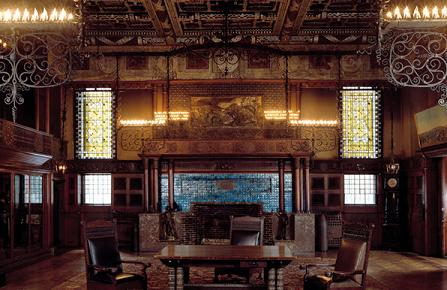 It is the only armory in the United States to be built and furnished with private funds. It originally served as the headquarters and administrative building for the 7th New York Militia Regiment. This group was known as the Silk Stocking Regiment due to the disproportionate number of its members who were part of the city's social elite. [1]. New York City came to depend on this militia, which regularly was asked to quell civil disorders such as the Astor Place Riot of 1849; it also helped fight large fires and took part in protecting citizens and businesses. Additionally, the Seventh Regiment participated in important events, such as the inaugurations of the Brooklyn Bridge in 1883 and the Statue of Liberty in 1886. It also guarded the remains of President Lincoln upon its arrival in the city. [10] The armory is known for detailed interior rooms that are furnished with ornamental woodwork, marble and stained glass. Noted architects and interior designers of the Victorian Era were commissioned to furnish the rooms and company quarters. The library is known as the Silver Room or "Trophy Room." It was designed by Louis Comfort Tiffany who worked with architect Stanford White as a consultant on the project. The masterpiece of the armory building is the Veterans Room, now called the Tiffany Room. It features hand carved wood paneling and coffered ceiling.[11].
The first home of the Seventh Regiment was on the lower East Side. However, by 1868 it was argued that the regiment needed to be in a neighborhood more convenient to its members as well as the population it protected, which was migrating north. In addition to a large hall (to be used to for arms and ammunition storage), the members wanted a ceremonial setting in which to impress recruits with the regiment’s glorious past. The reason I include this history is to show that the armory also functioned much like the men’s clubs of New York, which served social purposes. [10] As I continued to research the history of the armory, I learned the city was originally going to contribute large sums of money for the new building. However, due to difficult economic times, this did not happen. The regiment realized it had to make an effort to build the necessary armor by subscriptions from the active and veteran members of the Regiment, and from the citizens, business men, and tax-payers of the city of New York. Donations were received from prominent New Yorkers such as John Jacob Astor and William H. Vanderbilt. The growing middle class also participated, for they saw this as an opportunity to invest in its protection from civil strife. [10] As you will see in the following analysis, historical documents such as newspapers can help elucidate the role of certain elites in the financial structuring of the armory. 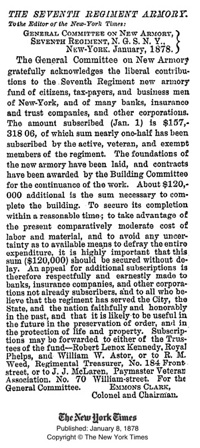 My initial research has indicated that the park avenue armory and its history are closely related to the elites of New York City. While this revelation proved to be an incredible point to start my inquiry into the history of the armory, I needed to confirm this claim through non-secondary sources. As such, I searched for archived newspaper articles that discussed the armory. I eventually came across an archived New York Times paper, dated January 8th, 1878. In this paper, I found a letter to the editorial from the General Committee on New Armory, Seventh Regiment, N.G.S.N.Y. The letter is closed by Emmons Clark, a Colonel and the chairman of the committee. [14] In the letter, we find a wealth of information about the funding of the armory. Recall that the city treasury was deplete to due to difficult economic times. It is abundantly conspicuous that problem was quickly solved. Clark acknowledges how “banks, insurance and trust companies, and other corporations” have put forth liberal contributions in addition to the funds raised from the “citizens, tax-payers, and business men.” Clearly, there must have been some agenda if insurance companies found it necessary to invest profits in a munitions storage facility rather than say, pay out dividends to its shareholders. We also see that among others, William W. Astor is listed as a contributor, which is confirms his presence in some of the secondary sources used.[14] Although there were many wealthy contributors, it is clear that numerous contributions from the general population were significant as well. For instance, we can see that tax payers contributed to the funding of the armory. Further, the letter states about one-half of the raised revenue thus far [in 1878] came from “active, veteran, and exempt members of the regiment.” This is interesting since Charles W. Clinton (who will be discussed in greater depth later) was not only the leading architect for the armory, but he was a veteran himself of the regiment! It is clear that veterans of the seventh regiment prided themselves in its establishment. We can see this theme in the letter – when Clark appeals to others for more funding, he refers to the armory’s role as a faithful and honorable institution that protects the city.[14] This letter to the editor of the New York Times helps to uncover some of the incredibly intriguing history of the armory. It has helped to elucidate some of the reasons for the large contributions to the armory. The financial elites had stakes in the armory and veterans felt a source of pride in helping out. It is unclear if this letter was actually published for the public to view, or if the letter was meant as a plea to the editor to find potential contributors to the armory’s funding. 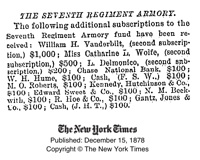
We can see that William H. Vanderbilt had one than one "subscription [donation]" to
the armory, each valued at $1000. Others listed are: Miss Catherine L. Wolfe ($500),
L. Delmonico ($200), Chase National Bank ($100), etc. The presence of Chase Bank
and several law firms (deducted from the "& Co." designation) indicates that financial
elites had a hand in funding the armory. It is interesting that a bank, which normally
finances construction, is actually donating money. Despite all this, even for the time period,
the financial contributions seem low for such financial institutions. It makes one wonder if
perhaps there are other "hidden transactions" between these entities.[15]
Now that we have looked closely at the Seventh Regiment Armory and the manner in which it was
financed, we will shift our focus (in the next section) towards two men (whose names were mentioned earlier) that greatly influenced the development of the armory.
The Dwellers of Park AvenueCharles W. ClintonThe armory was designed by the New York architect Charles William Clinton under the close supervision of Colonel Emmons Clark (1827-1905), the regiment's commander from 1864 to 1889. Clinton too was a member of the regiment and had created four company rooms in the Tompkins Market Armory.[2] The first person I researched is Charles William Clinton (1838, NYC – December 1st, 1910, NYC), an American architect who was instrumental in the formation of the Seventh Regiment Armory. After graduating from public school, Clinton studied architecture under Richard Upjohn. He later left to form a private partnership with William Hamilton Russell (thus forming the firm known as Clinton & Russell). Clinton and Russell was a well-known architecture firm founded in 1894 in New York City. Many of the structures they designed were in a Neo-Italian Renaissance style. The firm was responsible for numerous buildings throughout the city. Among the most prominent buildings erected by Clinton & Russell in New York City are the Wilkes Central Trust Company, the Metropolitan Trust Company, the Seventy-first Regiment Armory, and the Seventh Regiment Armory. Mr. Clinton was elected an Associate of the American Institute of Architects in 1858 and a Fellow in 1864. [16]After this preliminary online research, I looked to vital records to better understand Clinton. Ancestry.com proved to be an effective source. After locating the correct Clinton (verified via known birth and death dates), I learned the following about Clinton. His spouse was Emily Gorsuch, and his parents were Alexander Clinton and Adeline Arden Hamilton. Clinton’s son is Charles Kenneth Clinton (born circa 1890) and his daughter is Margery Hamilton Clinton (born circa 1894). I was able to locate an extended family tree that is an amalgam of various entries in the site’s database (see image to right). [17] In addition to the family tree, I was able to learn that after the deaths of Clinton and Russell, their firm continued, and in 1926 it was renamed Clinton & Russell, Holton & George. The primary source (a legal document indicating the firm’s name change) was not available, but the name change was presented as fact under the historical facts heading. [17]
  1870 Federal Census: At this point, Charles W. Clinton should be about 32 years old.
This particular section of the census was written on June 28, 1870. This census reveals that his father, Alex Clinton, is about 77 and his occupation is physician. Mary Blucker, age 48, “keeps house.” Charles W. Clinton is on the top of the second page, and his occupation is correctly listed as architect. We also see Julia and Ellen Connor, and one other (name is illegible) who are listed as domestic workers. [17]
1910 Federal Census: Here, we see Charles W. Clinton is age 72, his last year. He is listed as head of his family. Below him is Emily (Wife), Margery (daughter), and Charles (Son). Mary Collin, Annie Rowan, and one other (name is illegible) are listed as servants. While Charles W. Clinton is listed as an architect, the three servants are listed as maid, laundress, and chambermaid, respectively. Under the nature of business for the family, while other families are listed as “private” or “bank,” Clinton’s family is listed as “general.” [17] Here we can see a clear contrast with Clinton in his earlier days. As a child, his father was a doctor, and it seemed he lived in a more affluent milieu. Now, as a father himself, Charles W. Clinton is an architect. Although he has three servants as he did when he was in his thirties, Clinton's family is listed as "general" in the occupational sense. The surrounding families are "private" or bankers, indicating that the Clintons are not as wealthy. It seems in terms of socio-economic status, Clinton has "moved down" in a sense, over time. [17] Louis Comfort TiffanyThe next person I researched is Louis Comfort Tiffany (February 18, 1848 – January 17, 1933). He was an American artist and designer who worked in the decorative arts and is best known for his work in stained glass. He is most often associated with the Art Nouveau and Aesthetic movements. Tiffany was affiliated with a prestigious collaborative of designers known as the Associated Artists which included Lockwood de Forest, Candace Wheeler, and Samuel Colman. Tiffany designed stained glass windows and lamps, glass mosaics, blown glass, ceramics, jewelry, enamels and metalwork. [3] Vital records indicated that Louis was the son of Charles Lewis Tiffany, founder of Tiffany and Company, and Harriet Olivia Avery Young. Louis married Mary Woodbridge Goddard on May 15, 1872 in Norwich, Connecticut and had the following children: Mary Woodbridge Tiffany (1873-1963) who married Graham Lusk; Charles Louis Tiffany I (1874-1874); Charles Louis Tiffany II (1878-1947); and Hilda Goddard Tiffany (1879-1908). [3] After the death of his wife, he married Louise Wakeman Knox (1851-1904) on November 9, 1886. They had the following children: Louise Comfort Tiffany (1887-1974); Julia DeForest Tiffany (1887-1973) who married Gurdon S. Parker then married Francis Minot Weld; Annie Olivia Tiffany (1888-1892); and Dorothy Trimble Tiffany (1891-1979), who, as Dorothy Burlingham, later became a noted psychoanalyst and lifelong friend and partner of Anna Freud. Many of Tiffany’s descendants were active in the arts, politics, and the sciences.[17] Additionally, I was lucky enough to obtain a copy of Tiffany’s US Passport Application (see image below). [17] From the passport, we can verify that Louis’ father was indeed Charles, and that Louis initially resided in Oyster Bay, Long Island. His official occupation was that of an artist. It is interesting to note that at the bottom, it states that Tiffany pledged to leave the US via the “Port of New York” via the “SS Berengaria” on June 30th. However, the year is not present. Following the date (June 30th), there is simply the number 192 followed by “crossing out” of a number or letter, perhaps. [3]  A Modern Day FacadeNow that we have incorporated the historical presence of the armory into our narrative, it is only appropriate to analyze its present-day role in New York City. Here, we will take a look at how the armory's function has changed over time, from protector of civil-strife, to renter of private art show halls. [1] Today, the Seventh Regiment Armory is home to a number of art shows in NYC. The Armory provides a unique space for artists and curators to mount exhibitions. [18] 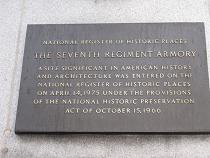
The above video and images are reminders of the incredible transformation that the Armory has undergone. At one point, the armory was a location for the economic elites to protect their "interests." Today, it is the site of private art shows. While the armory may seem (from a cursory glance) like a mere location for private space rentals, this is indeed a false front, or facade. Behind the doors and curtains lie numerous layers of secrets and histories, waiting to be uncovered. References
|

